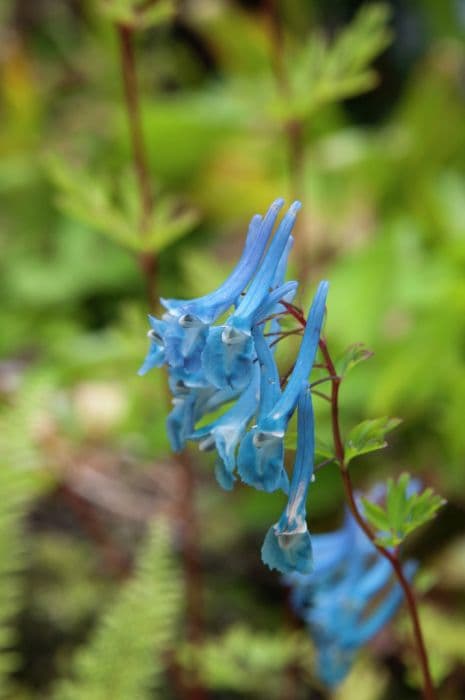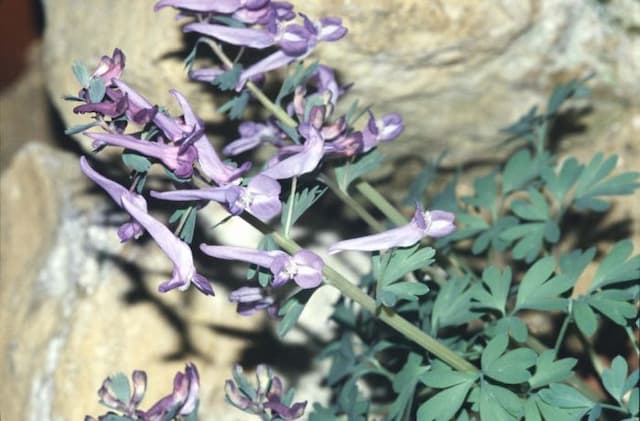Himalayan Blue Poppy Meconopsis Fertile Blue Group

ABOUT
The Meconopsis Fertile Blue Group, commonly known as Himalayan blue poppy, is a strikingly beautiful flowering plant known for its vibrant blue blossoms. The flowers of this plant have a luminous quality, with petals that appear almost silky or satiny in texture. The color of the petals can vary from a deep, rich blue to a lighter sky blue, and they typically consist of four to six broad, rounded petals that form a cup-like shape. In the center of the flower, there are numerous golden or yellow stamens that create a stunning contrast with the blue petals. The appearance of the stamens adds to the ornamental value of the plant, drawing the eye to the intricate details of each flower. The foliage of the Himalayan blue poppy is also noteworthy, comprised of leaves that are often deeply lobed or toothed, with a somewhat coarse texture. The leaves can have a green or blue-green color, providing an attractive backdrop to the spectacular blooms. The foliage may have a slight hairy or fuzzy texture, which can give the leaves a grayish cast, further accentuating the blue tones of the flowers. Overall, the aesthetic appeal of the Himalayan blue poppy lies in its unique and enchanting blossoms, which are treasured by gardeners and plant enthusiasts for their rare and alluring shade of blue.
About this plant
 Names
NamesSynonyms
Himalayan Blue Poppy, Tibetan Blue Poppy, Fertile Blue Poppy.
Common names
Meconopsis Fertile Blue Group.
 Toxicity
ToxicityTo humans
The Meconopsis plant, commonly known as the Himalayan blue poppy, is not typically considered toxic to humans. There is no well-documented evidence of toxicity resulting from ingestion of this plant, and it is generally regarded as safe. However, it is always prudent to avoid eating ornamental plants as they are not intended for consumption, and individual allergic reactions or sensitivities could occur.
To pets
The plant known as the Himalayan blue poppy is not commonly listed as toxic to pets. As with humans, there's no widely-known evidence to suggest that ingestion of Meconopsis species by pets would cause poisoning. Still, pets should not be encouraged to eat ornamental plants, and close observation is recommended if a pet does consume any part of the plant, as individual animals may have different sensitivities or allergic reactions.
 Characteristics
CharacteristicsLife cycle
Perennials
Foliage type
Deciduous
Color of leaves
Green
Flower color
Blue
Height
3 feet (0.91 meters)
Spread
1 foot (0.30 meters)
Plant type
Herb
Hardiness zones
5
Native area
Himalayas
Benefits
 General Benefits
General Benefits- Ornamental Value: The Meconopsis Fertile Blue Group, commonly known as Blue Poppy, has striking blue blooms that add a unique color and aesthetic appeal to gardens.
- Attracts Pollinators: Blue Poppies attract bees, butterflies, and other beneficial pollinators, promoting biodiversity in the garden.
- Cool-Color Palette: The plant's rare blue flowers contribute to a cool-color themed garden, which can create a sense of tranquility and serenity.
- Shade Tolerance: This plant can thrive in the dappled shade, making it suitable for garden spots that do not receive full sunlight.
- Unique Focal Point: Its distinct blue blossoms make it a conversation piece and a striking focal point in garden designs.
- Mountain Origin: With origins in the Himalayas, the plant is suited for rock gardens and alpine garden settings.
- Cold Tolerance: It can tolerate cooler temperatures, which makes it suitable for higher elevation gardens or cooler climates.
 Medical Properties
Medical PropertiesThis plant is not used for medical purposes.
 Air-purifying Qualities
Air-purifying QualitiesThis plant is not specifically known for air purifying qualities.
 Other Uses
Other Uses- The Blue Poppy's striking blue petals can be used as a natural dye for fabrics, providing a unique and vibrant blue hue.
- In arts and crafts, the petals of the Blue Poppy may be pressed and included in paper making for ornamental paper with a unique texture and color.
- Gardeners might utilise the dried seed pods of the Blue Poppy in floral arrangements, adding an exotic and artistic touch.
- Photographers often seek out Blue Poppy flowers as subjects due to their rare coloration and photogenic qualities in garden photography.
- As a symbol of remembrance in some cultures, Blue Poppies can be planted to create memorial gardens or spaces for contemplation.
- These flowers can be used in educational settings as an example of Himalayan flora and to teach about alpine plant biodiversity.
- The Blue Poppy, being a challenging plant to grow, is often used in horticultural circles to display gardening skill and expertise.
- Eco-friendly confetti can be made from the petals of the Blue Poppy, providing an environmentally safe alternative to traditional paper confetti.
- The Blue Poppy is sometimes used in literature and storytelling to represent ephemeral beauty or rarity, drawing from its fleeting blooming season.
- In landscaping, the Blue Poppy can serve as a "focal point" plant, drawing the eye and creating visual interest in garden design.
Interesting Facts
 Feng Shui
Feng ShuiThe Himalayan Blue Poppy is not used in Feng Shui practice.
 Zodiac Sign Compitability
Zodiac Sign CompitabilityThe Himalayan Blue Poppy is not used in astrology practice.
 Plant Symbolism
Plant Symbolism- Rarity: This plant, better known as the Himalayan Blue Poppy, is a rare and exquisite garden feature symbolizing the uniqueness and value of rare beauty in everyday life.
- Persistence: The Himalayan Blue Poppy thrives in specific conditions and can be challenging to grow, making it a symbol of persistence and determination.
- Tranquility: With its calming blue hue, the blue poppy is often associated with peace and tranquility, offering a sense of serenity to gardens and hearts alike.
- Success: If successfully cultivated, the Himalayan Blue Poppy can represent success against the odds, due to its reputation for being difficult to grow outside its native habitat.
 Water
WaterBlue poppies (Meconopsis Fertile Blue Group) require consistent moisture, so they should be watered deeply whenever the top inch of soil feels dry to the touch. Typically, this might mean watering once or twice a week, depending on the climate and weather conditions. The amount of water needed will vary, but aim for about 1 to 1.5 gallons every week during the growing season to maintain even soil moisture. Overwatering or allowing the plant to sit in soggy soil can lead to root rot, so ensure good drainage. In the winter, reduce watering to match the plant's reduced growth and need for water.
 Light
LightBlue poppies thrive in an environment with dappled shade or morning sun followed by afternoon shade. They prefer to be shielded from the intense midday sun, which can scorch their delicate leaves and flowers. A spot that mimics their native habitat, such as the filtered light beneath tall trees, would be ideal. They shouldn't be placed in deep shade, as this can lead to weak growth and fewer flowers.
 Temperature
TemperatureBlue poppies are best suited to cooler climates and can thrive within a temperature range of 50°F to 70°F. They can withstand temperatures down to about 32°F, but frost can damage the foliage and flowers. These plants may struggle in areas with temperatures that frequently rise above 75°F. Therefore, they prefer a cool environment and should be planted in a location that remains within their preferred temperature range throughout the year.
 Pruning
PruningPruning blue poppies is mainly done to remove spent flowers and any damaged or dead foliage, which encourages new growth and prevents disease. Deadheading after blooming can sometimes prompt a second, smaller flush of flowers. Pruning should be done as needed throughout the growing season, usually after the main bloom period in late spring or early summer. There is no set frequency for pruning; instead, monitor the plant's appearance and health to determine when pruning is needed.
 Cleaning
CleaningAs needed
 Soil
SoilThe Blue Poppy thrives in a soil mix that is acidic to neutral with a pH of around 5.5 to 7. A good blend consists of loamy soil enriched with leaf mold and perlite to ensure excellent drainage, as Blue Poppies do not like waterlogged conditions and require fertile, moist, yet well-draining soil.
 Repotting
RepottingBlue Poppies do not require frequent repotting and can be sensitive to root disturbance. They should be repotted only when necessary, which is typically every 2 to 3 years, ensuring not to damage the delicate root system during the process.
 Humidity & Misting
Humidity & MistingBlue Poppies prefer a high humidity environment, mirroring their native Himalayan habitat. Maintaining a humidity level of 60% to 70% is beneficial for their growth and bloom production.
 Suitable locations
Suitable locationsIndoor
Provide bright, indirect light and cool temperature.
Outdoor
Plant in partial shade, shelter from wind, moist soil.
Hardiness zone
5-7 USDA
 Life cycle
Life cycleThe Meconopsis Fertile Blue Group, commonly known as Himalayan Blue Poppy, starts its life as a seed, typically needing cold stratification to break dormancy and germinate. After sprouting, the seedling develops into a rosette of leaves at the soil level during its first growth phase. As it matures, a flowering stalk rises from the center of the rosette during the second year, showcasing the plant’s iconic blue blooms. Following pollination, often by bees attracted to the vibrant color, seeds are set and dispersed for the next generation. The plant then completes its life cycle by dying after seeding, as most Meconopsis varieties are monocarpic, flowering only once before death. However, if conditions are not favorable for flowering, some plants may delay blooming for several years, thus prolonging the vegetative stage in anticipation of more suitable conditions for reproduction.
 Propogation
PropogationPropogation time
Spring-Early Summer
The Himalayan Blue Poppy, also known as Meconopsis Fertile Blue Group, can be propagated most effectively by seed. The ideal time to sow seeds is from late winter to early spring, when temperatures are cool enough to support germination. While seeds can be started indoors, they require a period of cold stratification to break dormancy, which can be achieved by placing the seeds in a refrigerator for about four weeks. After stratification, seeds should be sown in a well-draining soil mix, barely covered with soil, and kept moist but not waterlogged. Germination usually occurs within three to six weeks. Seedlings should be acclimatized before transplanting outdoors after the risk of frost has passed. It's important to handle the delicate seedlings carefully and to ensure they receive ample shade and moisture as they establish.









